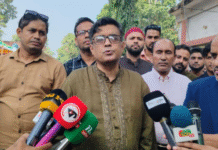
Rohingya children enter into Shah Parir Dwip at Teknaf crossing the River Naf as they flee from persecution by Myanmar forces in their homeland. — Sony Ramany
No end to the influx of Rohingyas into Bangladesh fleeing violence in Myanmar in sight as the exodus has increased after a few days as the ethnic minority people are coming from even deep into Rakhine state causing concerns.
Rohingyas fleeing violence in Myanmar said that they had stayed several days in forests almost without food, trekked through hills for several days before taking risky boat journey to save their lives.
They said that thousands more Rohingays were still waiting in forests and on hill slopes in Myanmar to contact with fellows already entered Bangladesh as Myanmar army and Rakhine people had been asking ethnic minority Rohingyas to leave the country
using public address system and set fire to their houses on September 26 and 27 at Buchidaung and Ranchidong areas of Maungdaw.
They also said that incidents of fire and bomb blasts were also reported from several villages of Buthidaung on September 22.
Local people said that influx slowed down in September 14-23 but the number of Rohingyas entering Bangladesh increased significantly in the past week
Terrified, exhausted and half-starved Rohingyas coming from several villages of Buthidaung behind Maungdaw, deep into Rakhine state, said that after Myanmar army and local Buddhists set fire to their houses, killed fellow villagers ahead of Eid-ul-Azha on September 2 they took shelter in forests near hoping against hope that situation would calm down.
‘But when they [army and Buddhists] continued their raid, we decide to leave the country to save life,’ said Jasir Hossain of Buthidaung, who reached Shah Parir Dwip at Teknaf in Cox’s Bazar Sunday morning.
Jasir, 30, came with his wife, four children and was waiting for his brothers to follow his suit. He said that thousands still were in forests and moving to Bangladesh.
‘Rakhine villages [Buddhists] nearby terrorised us asking to leave the country whenever we went to collect food to the village from hideout,’ said Nura Begum, 78.
Fisherman Mostafa Kamal, 60, of Shah Parir Dwip said that he could realise how so many groups of Myanmar people could came only from Buthidaung. ‘Certainly many more are coming as they have to trek through hill and forests and then cross the River Naf to reach Bangladesh from Buthidaung.’
UN agencies estimated that 5,07,000 Rohingyas had so far fled to Bangladesh to save life since August 25, when the violence which the United Nations termed a textbook example of ethnic cleansing erupted.
Officials estimated that the influx already took to 9.25 lakh the number of Myanmar people living in Bangladesh.
The ongoing ethnic cleansing began on August 25, when Arakan Rohingya Salvation Army reportedly attacked dozens of police posts and checkpoints and one military base in Rakhine. The insurgent group, however, said that it made the attacks to pre-empt military attacks on Rohingyas.
The United Nations said that the situation spiralled into the world’s fastest developing refugee emergency and a humanitarian and human rights nightmare.
Against this backdrop, Myanmar on Monday proposed to take back her nationals who had fled to Bangladesh only after October 2016 as more Rohingyas still continued to cross the border into Bangladesh.
Kyaw Tint Swe, minister of Myanmar state counsellor Aung San Suu Kyi’s office, placed the proposal at a meeting with Bangladesh side in Dhaka, foreign minister AH Mahmood Ali told journalists.
Bangladesh demanded return of all of over 9,00,000 forcibly displaced Myanmar nationals who crossed the borders into Bangladesh over the decades, they said.
A border guard patrolling Dakhinpara of Shah Parir Dwip, through which thousands of Rohingyas were entering Bangladesh after crossing River Naf, said that Rohingyas gathered on the Myanmar side and their contacts in Bangladesh sent fishing boats to help them cross into Bangladesh.
Agence France-Presse reported on Saturday that more than 2,000 Rohingyas massed along Myanmar’s coast this week after trekking from villages in Rakhine state to join the exodus to Bangladesh.
The crowds building up along Rakhine coast hailed from the same inland area Buthidaung.
Sabrang union parishad chairman Nur Hossain said that the number of Rohingays entering through different points increased a lot than that of the past week.
Rohinagys usually cross the River Naf at night and early morning and after paying rents they take shelter in the ground floor of Shah Parir Dwip Dakkhin Para Registered Non Government Primary School.
Mariuam Khatun, was trying to console her 10-month-old children at the school after fleeing Buthidaung, said that she could not feed her baby. ‘I have trekked through hills and forests for five days after hiding in a forest for seven days,’ she said adding that they lived on some food they carried with them.
As soon as Rohingyas reach at the school a group of local people helps them with dry food and provide some money and burqa to adult women in some cases.
Rohingyas are carried by pickup vans to local boat station to cross Pangar Khal (canal), whose water rise and fall with tides. ‘We usually take Tk 600 for a truck trip,’ said pick-up driver Anyet Ullah, adding that locals paid the rent.
After crossing the canal paying high boat fare, Rohingays need to trek through about a two kilometres muddy path, where they get another round of dry food with boiled eggs and some bananas and Tk 100-500 from locals.
Private service holder Hasibul Haq was found giving money to Rohinagys. Asked about the reason, he said that it was his humanitarian step to ease the sufferings of Rohingays.
Local people and Rohingyas said that as Rohingays crossed the border, border guards at border outposts allowed them to enter Bangladesh putting down a rough estimation in a register. In 10 minutes, 11:20am-11:30am, on Sunday New Age witnessed nine Rohingya families crossing the outpost.
After crossing the checkpoint, Rohingyas have reach Hasiakhali Governemnt Primary School, where Bangladesh Army with assistance from other voluntary organisations runs running a relief camp.
Handing over some relief materials, the relief camp officials send Rohingyas to Balukhali camp by trucks to join others entering earlier.
Jahangir Miah, 40, who was waiting to board a truck, said that they had no option but to leave their country. ‘I do not know what is waiting for us in the future.’
New Age correspondent in Cox’s Bazar reported that the number of Rohinagys entering through Palongkhali border increased on Sunday and Monday. Border guard battalion 34 commanding officer Manzurul Hassan said that at least 6,000 Myanmar nationals entered Bangladesh through Palongkhali border on Sunday and Monday.
After entering Bangladesh, Rohingyas took shelter wherever they could, in open spaces and forests, on hills and roadsides, living in putting huge pressure on existing water and sanitation facilities.
About five weeks after the eruption of the violence, a situation report released on Sunday by the UN and international agencies showed that many Rohinagys living in makeshift camps on hill slopes, cutting forests and in registered and unregistered overcrowded camps were living on a little food and almost without water and sanitation facilities.
The situation report estimated that 5 lakh Rohingyas still needed emergency food assistance, 3 lakh needed emergency shelter and 3.27 lakh needed sanitation and water assistances.
Cramped and crowded living conditions with lack of adequate water and sanitation continued to present significant risks of an outbreak of communicable diseases, said the report.
Disaster management and relief minister Mofazzal Haider Chowdhury Maya while distributing relief among Rohingyas at Ukhia on Monday said that there would no food crisis for Rohingyas.
‘Nothing to be worried, as long as Bangladeshis gets food, Rohingays would also get food,’ he said, hoping that the international community would continue their relief activities among Rohingyas.
Road transport and bridges minister Obaidul Quader while talking to reporters at a Cox’s Bazar hotel said that the government allocated 500 solar power-run street lights and 2,000 home system panels for 12 Rohingya camps.
On the day UNICEF launched a $76.1 million appeal for its emergency humanitarian response to the Rohingya crisis in Bangladesh.
About 60 per cent of the 507,000 Rohingya entering Bangladesh since August 25 are estimated to be children.
‘They need our help now and they need our help to have a future’, said UNICEF executive director Anthony Lake, who is visiting southern Bangladesh.
World Food Programme executive director David Beasley at press conference in Cox’s Bazar on Sunday reiterated its commitment to supporting Rohinagys fleeing violence in Myanmar.
‘I have heard heart-breaking stories today, speaking to people who ran for their lives and saw loved ones killed before their eyes. These horrors must stop,’ Beasley said, adding that ethnic minority group would receive WFP food assistance, until they returned home safely.
Source: New Age









